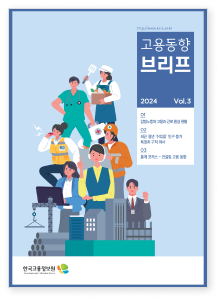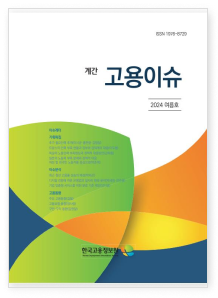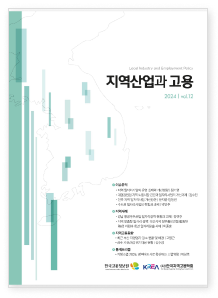Labor Market Analysis and Projection
Based on various statistical data and data collected through the national employment information system, we publish over 100 research
outputs annually and provide projections of changes in the labor market supply and demand structure in Korea for the next ten years.
Employment Trend Analysis
The employment trend analysis project utilizes the three primary employment administration databases—the employment insurance system, job opening and seeking system (WorkNet), and vocational training system (HRD-Net)—to produce valid statistical data for government labor policies, publish various materials on analysis results and job creation, and provide information on employment trends and essential data for policy decision-making.
While conducting timely and diverse employment trend analyses, we publish the 'Employment Trend Brief', Labor Market Analysis Report that is highly useful as primary data for employment policies. We also regularly publish 'Employment Issues' seasonally, which identifies the current position of our labor market through objective and professional labor market analysis, providing essential data necessary for achieving employment policy goals and establishing employment-friendly policies.
We publish the three primary employment administration DBs (employment insurance, WorkNet, vocational training) as periodic publications, such as monthly and annual reports, providing employment trend information by gender, age, employment type, industry, and occupation.
Furthermore, we have laid the foundation for big data research utilizing employment trends and administrative DBs by updating and analyzing various research and employment service administrative DBs. We conduct in-depth analysis research using administrative DBs on labor-vulnerable groups like youth and middle-aged/elderly, inter-regional labor mobility, and job transitions by industry.
- Types of Employment Trend Analysis Publications

- Employment Trend Brief
- Provides timely brief manuscripts on major employment trend issues.

- Employment Issues
- Serves as the representative publication of the Korea Employment Information Service, functioning as an information provision channel that examines labor market issues and introduces various in-house research activities.

- Monthly and Annual Reports of Three Major Employment Administration DBs
- Monitors and summarizes employment administration DBs, providing monthly and annual reports as primary data for understanding employment trends.

- Administrative DB publishes in-depth analysis reports
- An in-depth analysis reports that analyze the complex labor market and are usable as primary data for employment policies
Employment Panel Survey
The Employment Panel Survey project provides primary data for establishing and implementing employment and labor policies by producing statistical information on the overall employment situation, including employment structure and career paths of primary employment policy targets such as youth and middle-aged/elderly.
Korea Employment Information Service produces three-panel surveys: the Youth Panel Survey (YP), the Korean Longitudinal Study of Aging(KLoSA), and the Korean Longitudinal Study of Employment for the Elderly (KLoEE).
The Youth Panel Survey (YP) is conducted on a sample of 12,000 young people aged 19-28 as of 2021. It aims to understand the transition process from school to work and labor market paths to address youth unemployment issues.
The Korean Longitudinal Study of Aging(KLoSA) has been conducted since 2006 on middle-aged and elderly individuals aged 45 and over. It aims to capture various aspects of an aging society, including labor market participation, retirement, and income changes of the elderly. It also seeks to provide data for interdisciplinary research and international comparisons with advanced countries like the US and UK.
Korean Longitudinal Study of Elderly Employment(KLoEE) was launched in 2021 to produce primary data for developing and evaluating employment policies for middle-aged and older workers by analysis of the second baby boomers, who are beginning to retire from their primary jobs. The 1st Wave of the KLoEE was conducted on a sample of 9,358 ‘Second Baby Boom Generation’ born in 1964-1976.
- Main Survey Contents of Employment Panels
- Youth Panel(YP) Survey
- This survey investigates school life, job mobility, job search activities, qualifications, and career guidance to examine the 'transition process from school to labor market' for youth (aged 19-28).
- Korean Longitudinal Study of Aging(KLoSA)
- This study surveys various topics, including demographic background, family relationships, health status, employment status, consumption and income, assets, subjective expectations, and quality of life for middle-aged and elderly individuals (aged 45 and over).
- Korean Longitudinal Study of Elderly Employment(KLoEE)
- This study surveys employment status, working conditions and welfare, job search activities, job training and education, income and consumption, assets, and health of the second baby boom generation(born in 1964-1976) who are beginning to retire from their main jobs
Workforce Supply and Demand Projection
The workforce supply and demand projection is a project that predicts how the structure of workforce supply and demand in our labor market will change in the future. It aims to contribute to establishing stable human resource development policies for sustainable economic growth by projection of mid- to long-term workforce supply and demand. To this end, it diagnoses the impact of changes in the workforce supply environment, such as population effects and higher education. It derives mid- to long-term workforce supply and demand projections reflecting trends in workforce demand changes, such as technology adoption in digital transformation.
The Mid-to Long-term Workforce Supply and Demand Projection (2022-2032) is being pursued to provide guidelines on whether labor supply and demand will remain stable in the future by forecasting the population and the number of employed persons that will support continuous economic growth over the next ten years.
The Metropolitan Regional Workforce Supply and Demand Analysis aims to analyze the regional workforce supply and demand structure in five themes to smoothly carry out the "Metropolitan Regional Workforce Supply and Demand Forecast 2022-2032" in 2024.
The Short-term Job Outlook and Employment Fluctuation Analysis by Major Industries aims to provide essential data for solving job problems in major industries by reviewing the current job status of significant industries that account for a large proportion of domestic production and employment and presenting short-term job outlook results semi-annually.
The Digital-based Technological Innovation and Changes in Workforce Demand Structure has continued research on the impact of technological innovation on long-term workforce demand structure changes. It conducts industry-specific business and occupation-specific Delphi surveys to analyze the effects of technological changes due to digital transformation on job changes.
